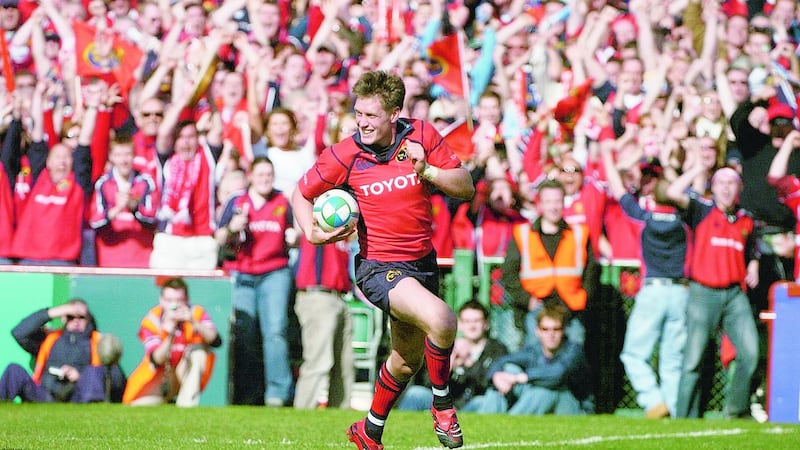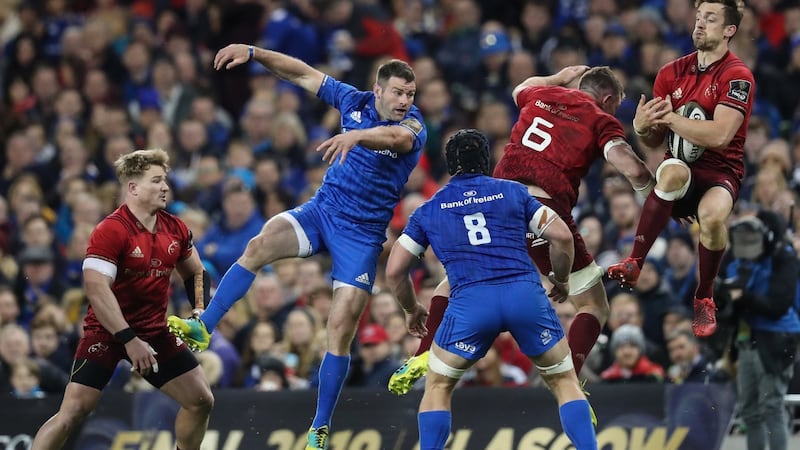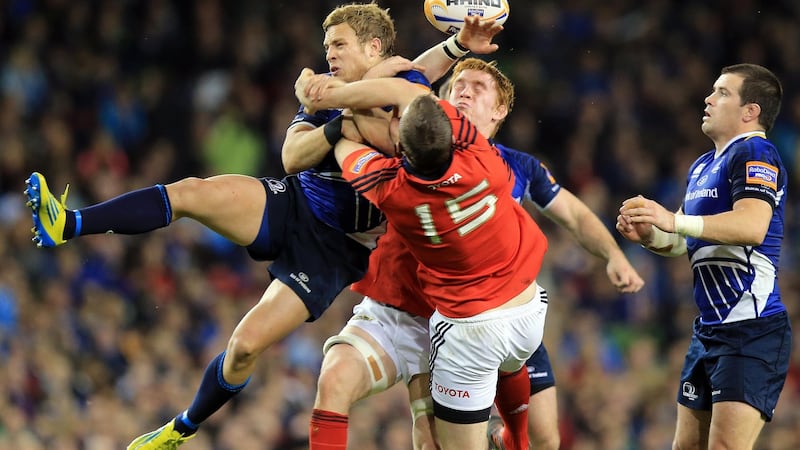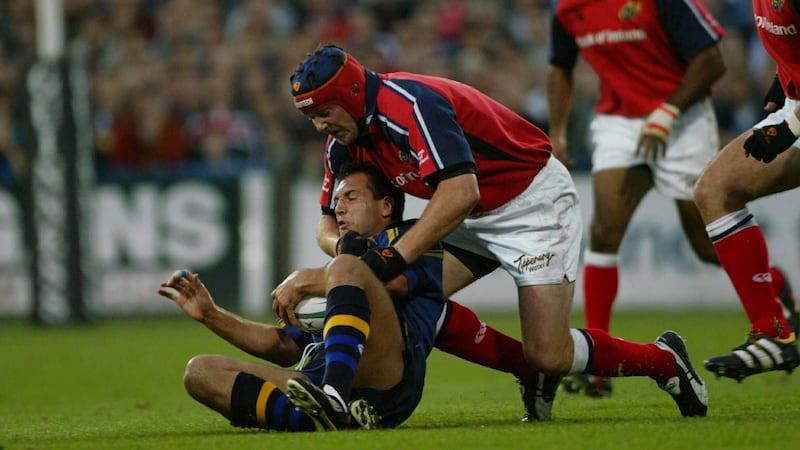Irish rugby is blessed when you come to think of it, not least in having the four proud provinces.
Put simply, no matter where an Irish rugby supporter is from, since the birth of professionalism, everyone can claim allegiance to at least one of the four professional teams that underpin the national team and compete in the Guinness Pro14 and European competitions.
Ireland is the only European country in which this applies. Even the Welsh regions, although designed to ensure the widest representation as possible, are a tad more contrived and don’t carry the same historical allegiance as is the case for the Irish provinces.
Nor can Edinburgh and Glasgow do this, or more obviously Treviso-cum-Zebre in Italy, or indeed the Top 14 or Gallaghers Premiership. The latter have a fair spread of 14 and 12 clubs, but they can only represent so many supporters.
The old interpros were never played in front of anything like the attendances which show up nowadays but at a stroke they provided a complete geographical spread to cover the entire island of Ireland.

Right now, the good times never seemed so good and no rivalry underpins this golden age in Irish rugby more than the one between Leinster and Munster. It dates back to 1879, when the provinces’ rugby teams were first founded, and in the professional era has even become the best-attended fixture in the global game below Test level.
Not that its potential was fully appreciated, despite clear warning signs. With the advent of the Celtic League and, effectively, the end of the Interprovincial Championship as we know it, Leinster and Munster were drawn apart in two pools of eight and seven teams. (The Welsh Rugby Union would subsequently merge their nine clubs into five regions, which became four, thus highlighting the original point).
As it happened, Leinster and Munster topped their respective pools and each won quarter-finals and semi-finals to contest the final at the old Lansdowne Road on Saturday, December 15th, 2001.
An estimated crowd of circa 30,000 turned up to see a high-quality game which Leinster won 24-20 despite the sending off of Eric Miller.
Yet despite that, they were again drawn separately in the two pools in 2002-03, when Leinster finished fifth in their pool and failed to progress. Connacht edged them out thanks in the main to a 26-23 win at the old Donnybrook, and so, for the first and only time since the second World War, the two provinces didn’t meet at all that season.
Someone sure missed a trick there!
Staple diet
With the Welsh trimming their sails into five regional teams, the Celtic League reverted to, well, just that, with a home-and-away format from the 2003-04 season onwards. This ensured that Leinster and Munster have met at least twice every season since then.
Even so, for the next three years, Munster hosted Leinster in Musgrave Park at varying points in the season, albeit capacity crowds witnessed the fixture on new year’s day and early October in 2004-05 and ’05-06, while Leinster won a new year’s eve thriller at the RDS in 2005-06 in front of a 14,000-plus attendance.
Finally they met for the first time in the competition at Thomond Park in the 2006-07 season and, in a foretaste on what has now become as much a staple diet of the festive period as turkey and ham, on December 27th.

Helped by the rivalry taking on a new dimension in the 2005-06 Heineken Cup semi-final at Lansdowne Road, a then capacity crowd of 13,200 saw Munster win 25-11. This was also the period of increasingly bitter relations between some of the rival players and some of the rival fans.
The fixture briefly returned to Cork while Thomond Park underwent full-scale redevelopment in 2008, Leinster winning 10-3 en route to a league double and the title, while Munster went on to conquer Europe for a second time.
For the last 11 years, Munster-Leinster has been played at Thomond Park, and invariably to close on, or complete, full houses, although for five years from 2008-09 to 2012-13, it had a post-Six Nations slot designed to ready either or both teams for the knock-out stages in Europe.
In 2013-14, the two fixtures were flipped, so that Munster hosted Leinster in early October (a fixture designed to fast-track their readiness for the opening pool salvos in Europe) and Leinster were at home for the end of March meeting in front of a capacity Aviva Stadium.
Only in the last four years has the Thomond Park meeting become a St Stephen’s Day fixture (three seasons ago it was on the 27th). This facilitated an opportunity for ex-pats flying home for Christmas to attend. But even allowing for supposed festive cabin fever and all that, there seemed something slightly unseemly about the game coming so soon after Christmas day. As if the attendees at extended family get-togethers couldn’t stomach each other for a day.
It must also have been a huge imposition on all those involved in the fixture, especially for the Leinster squad given they had to travel. For those having Christmas Day at home, such as Tadhg Furlong in Wexford, Sean O’Brien in Tullow and others, it usually meant having to return to Dublin on the night of Christmas Day for a morning coach journey to Limerick.
Noting the big crowds set to attend other derbies in the RDS, the Sportsground and the Kingspan Stadium over this period, Leo Cullen recently said with a dry smile: “Thomond is sold out as well on the 29th which is great. Hopefully, they won’t play us on the 26th any more.”
Big feed
After last Saturday’s dramatic comeback win over Connacht, the Leinster head coach maintained: “The 29th is a much more suitable date in my calendar anyway. I’m not sure about everybody else.”
In any event, for all the players and coaches involved, an impending Munster-Leinster game the next day must have hung over the traditional turkey and ham with family.
For example, injuries have restricted Rhys Ruddock to appearing in just one of the last four Christmas clashes in Limerick between the two provinces, when Leinster lost 29-17 two seasons ago.
But he is assuredly speaking for all the players when he says: “As amazing and special as the games are on St Stephen’s Day, I always like to have a big feed on Christmas day and I can’t help myself. Just to have those extra few days is nice and I think the atmosphere will be just as special down there so it’s a win-win for us.”

The festive rounds of interprovincial derbies have tended to highlight the issue of selections, with coaches understandably tending to prioritise home games in front of packed stadiums. In this, it is akin to the Top 14 in microcosm.
Mind you, this tends to affect Leinster less than other sides, given their unrivalled strength in depth, witness a record of five wins in those last ten visits to Thomond Park, which probably makes them the most proficient visitors to Munster’s citadel around.
The way the fixture has fallen on a Saturday, four days after Christmas Day, has seemingly allowed Cullen more scope to arrive there with what is more notionally a first-choice team.
Leinster have already experienced first-hand, especially in Toulouse and Bath, that as double champions they more than anybody are the hunted ones this season. And nowhere will this be truer than in Thomond Park. It’s partly why it’s been a sell-out for weeks.
We've had some great tussles down there over the years
But it is clearly a fixture Leinster anticipate every bit as much and one that they’ve had their eye on since the fixtures were revealed.
“Ah it’s great yeah,” said Cullen, relishing the prospect.
“It’s such a special occasion. We talk about the Aviva game but yeah, the Thomond game as well is a huge game in the calendar. We’ve had some great tussles down there over the years, both positive and negative ones. I’m sure everyone will be very very excited to see whatever teams do run out, because whatever 15 players are representing each team, they will do so, I’m sure, with a great responsibility that comes with representing their team. It’s a special fixture.”
Fundamental requirements
And being the away side, there are some fundamental requirements.
“You’ve got to respect the basics of the game because Munster will expose you,” said Cullen.
“They’ll always put pressure on the contact area of the game so that’s what we’ll be expecting and we just need to be a hell of a lot more accurate on next Saturday than we were tonight. It’s a great challenge for us.”
The notion of sides being full-strength in these days of squad depth and player management is a moot point, and perhaps too much is made of selection strategies.

Munster may have lost last week, but they did emerge with a bonus point at the death and the game also served its value in helping to fine tune some players on the road back from injury to full fitness.
“Jaco [Taute] got 80 minutes, Jean [Kleyn] got 65 or 70. Darren Sweetnam got 80, Tommy O’Donnell got 50. We want to take it step by step over the next few weeks. It’s the game of the season next week, then Connacht are playing really good rugby, we are away first. And then Gloucester and Exeter. It is brilliant to be part of this and with a few guys back and there may be good news on Chris Farrell in the next week or so.”
And as Van Graan added in the wake of Munster’s defeat to Ulster: “Last year it didn’t matter to them [Leinster] and we were 27-5 behind at half-time. I’m not a guy who makes predictions normally but I believe this will be Leinster versus Munster at full strength. Both teams will be as close to fully-loaded as can be.
If you are the PRO 14 and European champions, they are the team we aspire to be
“Obviously certain guys will need a rest and some of our guys need a two-week break. But from our side we are so looking forward to playing them at home again.
“We respect them and if you are the PRO14 and European champions, they are the team we aspire to be. I thought we played really well against them in the Aviva, we conceded an early yellow and 14 points. Then we got back to five but conceded a penalty from the kick-off.
“Now we’re at home and playing in front of a sell-out at Thomond which again, for a South African coming from outside, is brilliant for Irish rugby. Two Munster-Leinster sell-outs is great for Irish rugby.”













